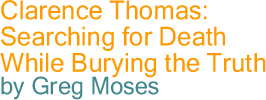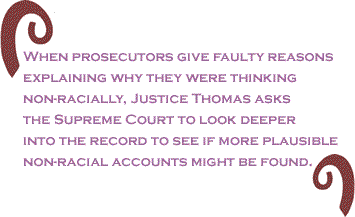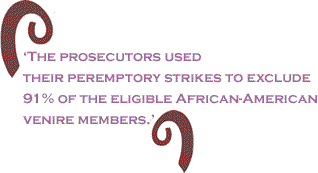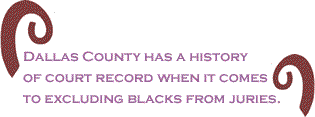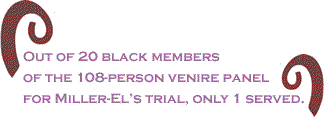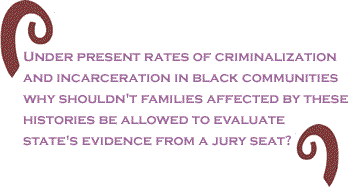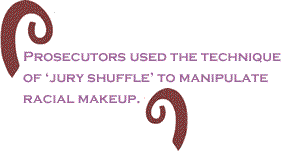
|
|||||||||||||||||||||
|
This article originally appeared in The Texas Civil Rights Review, under the title, “Race Bias and the Death Penalty One More Time: The Supreme Court Decision on Texas Death Row Prisoner, Thomas Miller-El.” In the recent dispute between Supreme Court justices over the question of race discrimination in jury selection, we find two warring camps of legal theory. By issuing its order to give one death row prisoner a new trial in Texas, the court majority seems to be forging a legal theory that can advance the long, good fight for racial justice. On the other side are some truly dangerous leanings. In the logical dispute between a six-Justice majority led by David H. Souter and a three-Justice dissent led by Clarence Thomas we find the majority holding prosecutors strictly to account for the reasons they actually give when explaining under oath why theyexercised peremptory strikes against black candidates for jury duty. What the prosecutor actually says about his or her reasons is what the majority tests for soundness. On the dissenting side, however, we find that when prosecutors give faulty reasons explaining why they were thinking non-racially, Justice Thomas asks the Supreme Court to look deeper into the record to see if more plausible non-racial accounts might be found. In death penalty cases, which logical method seems better for the Supreme Court to adopt: demanding that prosecutors give coherent reasons the first time when asked to show why their peremptory strikes were not racially motivated? Or shall we instead allow prosecutors to get close enough for government work, assuring them that the ruling minds of the judicial system will be standing by to find better race-neutral accounts if needed?
Or here's another question. When a black man sitting on death row wants to appeal his death sentence because he feels that black jurors were banned from his trial BECAUSE they were black, should we allow that death row prisoner to introduce jury cards, questionnaires, and testimony used to select the jury? For the majority opinion in the case of Texas death row inmate Thomas Miller-El, the answer is clearly yes, the prisoner is entitled to carry with him on appeal the jury selection documents that were used at his trial. But for the dissenting minority, access to jury selection docs should be limited on appeal. Justice Thomas argues that once a trial is over, and the death penalty has been awarded, then death row prisoners can only re-try issues and documents that they found relevant during jury selection itself. If after the trial is over a more complete review of the jury selection process yields new arguments for finding race discrimination, the minority view would tell the death prisoner, sorry, too late. Thomas argues that trial judgments should not be reversible on the basis of new issues found in fuller review of jury selection materials. If defendants fail to discern the best case for race discrimination the first time around, it is simply “unrealistic” to expect the trial court to know what was never pointed out, and if the trail court didn't know it at the time, then it can't be revisited on appeal. On the other hand, the majority opinion argues that a court may be held accountable for making the best possible ruling based on the complete record at hand, whether the judge actually takes the time to know it or not. Death row prisoners therefore have the right to go over everything once again with a fine toothed comb. Working in the legacy of the late Justice Thurgood Marshall, the majority of the Supreme Court seems to appreciate the care that has to be taken with logical analysis when you set out to find patterns of race bias. Sophisticated players in the race bias game are quite often difficult to catch. In a culture of race bias the players may not be fully aware of the bias they are exercising. In a concurring opinion by Justice Breyer, the Supreme Court reminds us what Marshall predicted: that so long as peremptory strikes are used in jury selection, there will never be a failsafe method to disable their usefulness to racial bias. In the case of Miller-El, it took nearly two decades to produce a winning case by means of “disparate impact” analysis. By means of this method of analysis, the majority of the court was convinced that if prosecutors were taken at their word about the reasons they gave for striking certain black panelists, then certain nonblack panelists should have been stricken as well. But by carefully weighing the prosecution’s "stated reasons" (not the best possible reasons that were available whether they stated them or not) and measuring those reasons against the full evidence of the jury selection process, the majority agreed that a racial bias was detectable. In contrast to Justice Thomas' attempt to show that a kind of non-racial explanation could be found, the concurring opinion by Justice Breyer draws on advancing scholarship in the psychological and social sciences to cast deeper inquiries into embedded structures of prejudice. In this battle between competing logics of race bias analysis, which one do we want guiding the Supreme Court? The one that tends to narrow the field of inquiry into possible race bias or the one that tries to keep up with ways that we are learning to see more clearly? These are just some of the issues that emerge from a blow-by-blow reading of the Miller-El decision handed down on June 13. While it is instructive to follow this pioneering skirmish in the logic of death row justice let's not forget that in 21st Century USA, the construction and maintenance of death row facilities is a barbaric foundation for anything that resembles truth or justice. As we will see below, Thomas makes a crucial claim about death penalty cases that should serve as a basis for abolishing the death penalty altogether. At least listen to the man on Death Row
As far as the Fifth Circuit Court of Appeals was concerned, the case was twice closed. And Justice Thomas would never have allowed an appeal. But on Monday a Texas death row prisoner won a majority ruling from the US Supreme Court that jury selection for his 1986 murder trial was flawed by racial discrimination. In 2001 the federal appeals court first attempted to close the case of Texas death row prisoner Thomas Miller-El by refusing to hear his argument that his jury had been selected in a discriminatory fashion. The trial judge in Miller-El's case had been instructed by the appeals court to review prosecution "strikes" against Black jurors to make sure they were not the result of "racial bias" and the trial judge ruled that in each case the prosecution gave valid "race neutral" reasons. On that basis, the appeals court refused to consider an appeal. But in 2002 the US Supreme Court said it would at least listen to Miller-El's plea that the case was appealable. "After examining the record of Miller-El’s extensive evidence of purposeful discrimination by the Dallas County District Attorney’s Office before and during his trial," the Supreme Court in 2003 ruled that an appeal was in order. “The prosecutors used their peremptory strikes to exclude 91% of the eligible African-American venire members," wrote the Supreme Court at that time. "Happenstance is unlikely to produce this disparity.” The Supreme Court sent the case back to the Fifth District for a hearing.
"During jury selection in Miller-El’s trial for capital murder, prosecutors used peremptory strikes against 10 qualified black venire members," recalls Justice Souter in Monday's opinion (with STEVENS, O’CONNOR, KENNEDY, GINSBURG, and BREYER concurring). "Miller-El objected that the strikes were based on race and could not be presumed legitimate, given a history of excluding black members from criminal juries by the Dallas County District Attorney’s Office." Fifth Circuit judges listened to Miller-El's appeal as ordered, but they ruled against him in 2004, finding that race-neutral explanations for striking the black panelists were plausible. Once again Miller-El went to the Supreme Court. In Monday's ruling the Supreme Court says to the Fifth Circuit: "again we reverse." Putting together a pro-death jury "When the government’s choice of jurors is tainted with racial bias," argues Justice Souter, "the very integrity of the courts is jeopardized." In the case of Miller-El, the Supreme Court again this week ruled that the numbers are "remarkable": "Out of 20 black members of the 108-person venire panel for Miller-El’s trial, only 1 served. Although 9 were excused for cause or by agreement, 10 were peremptorily struck by the prosecution." "More powerful than these bare statistics," says the Court this time around, "are side-by-side comparisons of some black venire panelists who were struck and white panelists allowed to serve." Although one black panelist (we'll use his initials BJF) was struck from the jury pool by the prosecution for saying that "life imprisonment would give an individual an opportunity to rehabilitate" there were at least two white jurors and a Hispanic who expressed similar views about rehabilitation but who were not struck.
Says Souter, a complete reading of the evidence shows that the black panelist, "should have been an ideal juror in the eyes of a prosecutor seeking a death sentence, and the prosecutors’ explanations for the strike cannot reasonably be accepted." After all, the panelist had said in court that if the state puts someone to death, then it must be God's will. "He testified that he had no religious or philosophical reservations about the death penalty and that the death penalty deterred crime," reports Justice Souter. "He twice averred, without apparent hesitation, that he could sit on Miller-El’s jury and make a decision to impose this penalty." Justice Souter takes lower courts to task for not noticing that the prosecution's explanation for removing BJF had mischaracterized the black panelist's views. "He [the prosecutor] represented that [the panelist, BJF] said he would not vote for death if rehabilitation was possible, whereas [BJF] unequivocally stated that he could impose the death penalty regardless of the possibility of rehabilitation." writes Souter. "Perhaps [the prosecutor] misunderstood, but unless he had an ulterior reason for keeping [BJF] off the jury we think he would have proceeded differently."Souter discounts the prosecution reason not only because it mischaracterized the juror's position, but also because the prosecutor under oath added the following sentence:
For Souter, the tentative qualifier served as evidence that the prosecutor may have been able to offer non-racial reasons for the strike, but was also preparing ground to change those reasons, which in fact he soon did. The panelist had a relative in the criminal justice system, explained the prosecutor. But why did the prosecutor not offer that reason first? Under these circumstances the "new explanation" says Souter "reeks of afterthought" and "makeweight." A jury of one’s peers – or executioners? In a closely argued dissent, Justice Thomas writes that Miller-El is the party of afterthought who changes the basis of his argument with each new venue of appeal. In panelist BJF, Thomas did not find Souter’s “ideal juror” who saw the hand of God acting in state executions. Instead, Thomas said the religious onvictions of the panelist gave prosecutors good reason to fear that he would be reluctant to issue a death penalty. “Those fears were confirmed by [the panelist’s] view that all people could be rehabilitated if introduced to God,” writes Thomas, “a fear that had special force considering the special-issue questions necessary to impose the death penalty in Texas.” Texas jurors delivering a death penalty have to agree unanimously that “there is a probability that the defendant would commit criminal acts of violence that would constitute a continuing threat to society.” When panelist BJF testified that ach and every person is capable of rehabilitation, prosecutors feared that he would never be able to agree that a defendant had the probability of being a “continuing threat to society.” As Thomas admits, however, BJF did testify “that he could impose the death penalty, even on a defendant who could be rehabilitated.”
For Thomas, it was panelist BJF who had the pretext for getting on the jury, not the prosecutor who had the pretext for keeping him off. And yes, while explaining his reason, the prosecutor did mischaracterize the testimony to some degree, admits Thomas, ut a careful reading of the transcript shows that prosecutors had good reasons to strike BJF even if they didn't state those reasons as carefully as they should have. For Souter, however, the Supreme Court is not supposed to help the prosecution find the best non-racial reasons for striking a juror. The Supreme Court is supposed to evaluate the reasons given by the prosecution in order to determine if racial discrimination might be going on. When a prosecutor fails to state his best non-racial reasons for striking a juror, why should the Justices rehabilitate his case?Based on reasons stated for striking black panelist BJF, Justice Souter finds three nonblack panelists who should have been equally disqualified but who did not attract prosecution strikes. Justice Thomas, working from his rehabilitated logic of “actual reasons” (not actually given) found that the nonblack jurors identified by Souter were in fact more favorable for the prosecution overall. For example, while the stricken black panelist was related to a one-time prisoner, the nonstricken white panelist was related to an agent of the FBI. In this dispute over panelist BJF, Souter and Thomas are arguing from two different places. While Thomas finds a more plausible non-racial account than the one actually put on record, Souter tests the reasons given on the record and tosses them out if they don’t fit a coherent non-racial account. The white panelist from the FBI family also testified that she would be reluctant to give the death penalty in a case where rehabilitation was possible. If the prosecution struck the black panelist for similar reasons, why did they not strike her? What neither side in the dispute addresses is the racialized impact of selecting jurors on the basis of family affiliations. ithhigh rates of criminalization among black men in the USA, the "non-racial" search for jurors who have no criminals in the family will surely in the long run disable an important pool of peers. Under present rates of criminalization and incarceration in black communities why shouldn't families affected by these histories be allowed to evaluate state's evidence from a jury seat? Black jurors strike out In the prosecution's strike against another black panelist (again we'll use his initials, JW) Souter finds another example of disparate treatment. Although the panelist repeatedly says thathe would be able to hand down a death penalty, he does admit to having "mixed feelings" about the actual punishment that the death penalty brings. By shortening the life of a killer, the death penalty might be viewed as relieving the suffering of "personal punishment." The prosecution claims that the opinion cost the panelist a chance to serve on a death penalty jury. Yet four other panelists who were not struck also said the death penalty might be viewed as the "easy way out" – including a white juror and the lone black juror who was seated. As for that lone black juror, Souter sets the stage of ircumstance. Having used 11 of its 15 peremptory strikes, the prosecution was looking at three upcoming panelists who had already expressed in writing that they were opposed to the death penalty. The prosecution would need to save three strikes for them. “In fact,” argues Souter, “if the prosecutors were going to accept any black juror to obscure the otherwise consistent pattern of opposition to seating one, the time to do so was getting late.” It is not the business of the courts to clean up the reasons that prosecutors actually give for their strikes says Souter. Even if the ppeals court and dissenting justices find more defensible reasons for striking jurors, it "does nothing to satisfy the prosecutors’ burden of stating a racially neutral explanation for their own actions." Too many Blacks spoil the scheme In the 2003 ruling that sent Miller-El back to the appeals court, the Supreme Court found that prosecutors also used the technique of "jury shuffle" to manipulate racial makeup. If "too many" black panelists were sitting at the front of the jury pool, prosecutors would "re-shuffle" the jury in hopes of moving more lack panelists to the back. "At the beginning of the third week, the first four panel members were black. The prosecution shuffled, and these black panel members ended up at the back. Then the defense shuffled, and the black panel members again appeared at the front. The prosecution requested another shuffle, but the trial court refused."
When black panelists can't be shuffled to the back, they might be prompted to sound a little more hesitant about applying the death penalty. During questioning, prosecutors used two scripts leading up to the death penalty questions. One was a bland statement of the prosecution's intent to seek the death penalty and it was used 91 percent of the time during the questioning of white panelists. For half of the black panelists however another script was used: "When the death penalty is assessed," said the prosecutor to half the black panelists, "at some point Mr. Thomas Joe Miller-El – the man sitting right down there – will be taken to Huntsville and will be put on death row and at some point taken to the death house and placed on a gurney and injected with a lethal substance untilhe is dead as a result of the proceedings that we have in this court on this case." How would you feel about the death penalty if the question were put that way? The more a panelist squirms at the thought of execution, the less qualified she becomes for jury duty in Texas. While half of the black panelists were given the squirmy script, 94 percent of the white panelists were not. Souter does not buy the case offered by Texas that the graphic script was given for non-racial reasons in order to flush out previously identified noncommittal panelists. The alleged non-racial patterns, says Souter, do not fit the facts. Different scripts for different folks "The same is true for another kind of disparate questioning, which might fairly be called trickery," writes Souter. "The prosecutors asked members of the panel how low a sentence they would consider imposing for murder. Most potential jurors were first told that Texas law provided for a minimum term of five years, but some members of the panel were not, and if a panel member then insisted on a minimum above five years, the prosecutor would suppress his normal preference for tough jurors and claim cause to strike." If the Supreme Court wants to call it trickery when some black jurors are disqualified for failing to enthuse about the death penalty strongly enough while other black panelists are tossed out for feeling too strongly about minimum sentences, then why would we want to re-phrase? Trickery it is. But it is especially exasperating trickery for Souter who pastes into his 2005 opinion the findings of the 2003 Supreme Court that the "mandatory minimum" trick was played on 88 percent of the black panelists in the Miller-El trial and six percent of the whites. Yet Souter takes pains to note that those Supreme Court findings from "Two Terms ago" had no effect on the Fifth Circuit Court of Appeal. After this, Souter pastes more excerpts from the 2003 findings, establishing that Dallas County has a history of court record when it comes to excluding blacks from juries. When courts are aware that a local pattern of bias exists, shouldn't they take extra pains to review claims of bias in those areas? The Supreme Court had already intervened once. Why is the Fifth District being so stubborn in its refusal to take direction? Evidence most vile
Justice Breyer's concurring opinion begins by remembering Thurgood Marshall's opinion that the only way to eliminate the discriminatory use of jury strikes would be to eliminate jury strikes themselves. "To begin with," writes Breyer, "this case illustrates the practical problems of proof that Justice Marshall described. As the Court’s opinion makes clear, Miller-El marshaled extensive evidence of racial bias. But despite the strength of his claim, Miller-El’s challenge has resulted in 17 years of largely unsuccessful and protracted litigation – including 8 different judicial proceedings and 8 different judicial opinions, and involving 23 judges, of whom 6 found the Batson standard violated and 16 the contrary." Even with the evidence and the backing of the Supreme Court on his side, Miller-El lost his case before most of the judges he faced by a nearly three-to-one margin. Thurgood Marshall could see this day coming. After a dense survey of law, psychology, and social science, Breyer concludes that, "the use of race- and gender-based stereotypes in the jury-selection process seems better organized and more systematized than ever before." "For example, materials from a legal convention, while noting that 'nationality' is less important than 'once was thought,' and emphasizing that 'the answers a prospective juror gives to questions are much more valuable,' still point out that '[s]tereotypically' those of 'Italian, French, and Spanish' origin 'are thought to be pro-plaintiff as well as other minorities, such as Mexican and Jewish[;] [P]ersons of German, Scandinavian, Swedish, Finnish, Dutch, Nordic, British, Scottish, Oriental, and Russian origin are thought to be better for the defense'; African-Americans 'have always been considered good for the plaintiff,' and '[m]ore politically conservative minorities will be more likely to lean toward defendants.'" If England can do away with jury strikes, argues Breyer, why can’t we? Time may be coming when the Supreme Court will be able to strike down jury strikes altogether. In dissent, Justices Thomas, Rhenquist, and Scalia argue that the majority should not have been able to test the validity of non-racial reasons against juror cards and questionnaires, because these materials were never part of the evidence considered by the trial court. Souter replies that since juror materials were part of the original records of the state court, they are fair game for appeal, even those parts that were not identified as significant at the time of trial. Clarence Thomas: The High Executioner In his dissent over the use of juror records, Justice Thomas seems to talk past his own characterization of the majority opinion. In the words of Thomas, the majority argues that records used to appeal the jury selection "might not expand on what the state trial court knew"; which seems to say that the jury-selection materials actually used at the time of trial really bring nothing new into the record. But when Thomas argues that the majority claim is "incorrect" he shifts the question away from "what the state trial court knew" to what Miller-El actually referenced in his jury-selection appeals. It is strange that Thomas would first characterize the question of appealable materials as one of determining "what the trial court knew" but then base his dissent to the question of what Miller-El selected from that record as racially biased at the time he first objected in state court. In the shift of emphasis between trial records used and trial records pointed to by the defendant, Thomas seems to argue that a state court should only be held responsible for "knowing" those parts of the record that that defendant points out. "Miller-El’s arguments gave the state court no reason to go leafing through the voir dire transcript," says Thomas. "What is more, voir dire at Miller-El’s trial lasted five weeks, and the transcript occupies 11 volumes numbering 4,662 pages. To think that two years after the fact a trial court should dredge up on its own initiative passing references to unseen questionnaires – references buried in a more than 4,600-page transcript no less – is unrealistic." Even if Thomas is correct to argue that a trial court judge cannot be expected to actually "know" everything in the record, it seems odd to conclude that the "actual knowledge" of the judge as a person should serve as the limiting criterion for what can be appealed after the trial is over. When a difference is established between a judge's actual ignorance of facts in the record and what the record preserves, the more objective and fair determination of "what the trial court knows" would seem to fall on the side of the documentary record. Something cold is suggested when Thomas complains that trial courts cannot be expected to completely consider their own records of jury selection in death penalty cases. In fact, these very limits of knowledge would make a fine argument for abolishing the death penalty altogether. As Thomas points out, the certainties required to make sure that the death penalty is fairly administered are "unrealistic" to expect at the trial court level.
Thomas complains that the logic of "disparate treatment" analysis has been introduced very late in the appeals process. In freezing the logic of analysis at the level of the state court, Thomas narrows considerably the power of federal appeals courts to join defendants in looking for patterns of discriminatory behaviors in state courts. But in racist USA, what better reason would we need for having a federal court in the first place? In the subtext of the Miller-El ruling, the validity of "disparate impact" logic serves as the life preserver of racial justice, bobbing up once again, presumably to the irritation of Thomas and his fellow dissenters. But “disparate impacts” are often difficult to detect in the flow of lived experience. By definition they can never be found in any individual act. The logic of “disparate impact” requires careful analysis of patterns of action over time, space, and circumstance. Because this pattern-seeking analysis requires some distance from the individual actions in question, what is truly "unrealistic" is the expectation of Justice Thomas that well-developed disparate impact analysis must only be developed at the trial court level. And because the ability to rationalize disparate impact also grows in sophistication over time, it will be wise to take the suggestion of Thurgood Marshall and eliminate the kinds of arbitrary court practices that can be used to craft discriminatory outcomes. But in closing I'd like to come back to the complaint made by Justice Thomas that the complete records of these death penalty cases are in a very practical way unknowable. And when we have unknowable bodies of evidence upon which we are basing executions in a country and a state with such clear patterns of racial bias as exist in the USA and Texas, it is simply unconscionable that the Supreme Court still allows the death penalty at all, never mind the continuing use of peremptory strikes. Greg Moses is editor of the Texas Civil Rights Review and author of Revolution of Conscience: Martin Luther King, Jr. and the Philosophy of Nonviolence. His chapter on Civil Rights under Clinton and Bush appears in Dime's Worth of Difference, edited by Alexander Cockburn and Jeffrey St. Clair. |
Your comments are always welcome. Visit the Contact Us page to send e-Mail or Feedback or Click here to send e-Mail to [email protected] e-Mail re-print notice
If you send us an e-Mail message we may publish all or part of it, unless you tell us it is not for publication. You may also request that we withhold your name. Thank you very much for your readership. |
| June 23 2005 Issue 143 |
|||||||||
|
|||||||||
|
|
|||||||||
| Printer Friendly Version | |||||||||
 |
|||||||||
 |
|||||||||
| |
|||||||||
| |
|||||||||





















